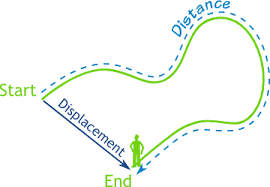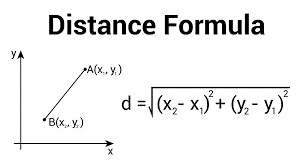Distance DefinitionDistance is a numerical measurement of the physical or spatial separation between objects, locations, or points in space. It is a fundamental concept in mathematics, physics, and other sciences that deal with spatial relationships. Distance is typically measured using standard units such as meters, feet, miles, or kilometers, depending on the context and the level of precision required. The concept of distance is also widely used in everyday life, for example, in travel, navigation, sports, and other activities where spatial relationships are important. Measurement of DistanceThe distance can be measured using various techniques and instruments, depending on the accuracy level and the measurement scale. Here are some common methods of measuring distance:
These are some of the common methods used for measuring distance. The choice of method depends on the specific situation and the level of accuracy required. What are Spatial Relationships?Spatial relationships refer to how objects or locations are positioned about each other in physical space. It entails an examination of the dimensions, arrangements, and relationships between objects. Spatial relationships are important in various fields, such as geography, architecture, mathematics, physics, and computer science. In geography, spatial relationships describe the locations and distribution of various phenomena such as population, land use, and natural resources. For example, spatial analysis can be used to understand how the availability of water resources varies across a region. In architecture, spatial relationships are used to create structures and interior layouts that are both practical and aesthetically beautiful. Architects use various techniques like scale models and computer-aided design (CAD) software to create spatial relationships between different building parts. In mathematics, spatial relationships are used to study geometric shapes' properties and their relationships. The Pythagorean theorem, which asserts that in a right triangle, the square of the length of the hypotenuse is equal to the sum of the squares of the other two sides, is an illustration of a fundamental idea in spatial relationships. In computer science, spatial relationships are used in geographic information systems (GIS), which involve storing, analyzing, and manipulating geographic data. Urban planning, environmental management, and disaster response are just a few of the uses for GIS. In summary, spatial relationships are fundamental to understanding the physical world. They are used in various fields to study and analyze the arrangement of objects and locations in physical space. Distance in PhysicsIn physics, distance is a fundamental concept that describes the physical separation between two objects or points in space. Distance is an important quantity in physics because it is used to calculate other physical quantities such as speed, velocity, acceleration, and force. In physics, distance is typically measured in meters (m) or other units such as kilometers (km) or miles (mi). The length of the path taken by light in a vacuum over some time equal to 1/299,792,458 of a second is the definition of the meter, the SI unit of distance. 
Distance is related to other physical quantities through mathematical equations. For example, speed is defined as the distance traveled per unit of time, which can be expressed mathematically as: Speed = Distance / Time Velocity is a vector quantity that describes the rate of change of distance concerning time and includes the direction of motion. The rate of change in velocity concerning time is known as acceleration. This law relates to distance, force, mass, and acceleration, all important quantities in physics. In addition, distance plays an important role in the laws of motion, such as Newton's laws. For example, Newton's second law states that the acceleration of an object is directly proportional to the net force acting on the object and inversely proportional to its mass. In summary, distance is a fundamental concept in physics that is used to describe the physical separation between two objects or points in space. It calculates other physical quantities such as speed, velocity, acceleration, and force and is a crucial concept in the laws of motion. Distance in MathematicsIn mathematics, distance is a fundamental concept that describes the separation between two objects or points in space. The distance between two points is usually measured in terms of the length of the straight line connecting them, called the "line segment." Distance is a key concept in geometry, the branch of mathematics that studies the shapes, sizes, and positions of objects in space. In geometry, distance measures the separation between two points in a Euclidean space. In this context, the distance between two points is defined as the shortest path length between them called the "geodesic." The geodesic can be a straight line in the case of two-dimensional space or a curved line in higher-dimensional space. Distance is also an important concept in analytic geometry, which uses algebraic methods to study geometry. In analytic geometry, the distance between two points in a two-dimensional Cartesian coordinate system is given by the distance formula: d = sqrt((x2 - x1)^2 + (y2 - y1)^2) Here, (x1, y1) and (x2, y2) are the coordinates of the two points, and d is the distance between them. 
Distance is used in many areas of mathematics, including calculus, linear algebra, and topology. In calculus, distance defines limits, which is essential for studying derivatives and integrals. In linear algebra, distance is used to define norms, which measure the size or magnitude of vectors. In topology, distance defines a metric space in which distances between points are defined. In summary, distance is a fundamental mathematical concept that measures the separation between two points or objects in space. It is a key concept in geometry, analytic geometry, calculus, linear algebra, and topology. Remote LearningRemote learning, also known as distance learning, is a form of education where students and teachers are not physically present in the same location. Instead, remote learning occurs through technology, such as computers, the internet, and other digital media. Remote learning has become increasingly popular in recent years due to technological advances and the need for flexible learning options. Remote learning can take many forms, including online classes, video conferencing, pre-recorded lectures, and interactive software. It can be delivered synchronously, where students and teachers interact in real-time, or asynchronously, where students can access materials and complete assignments at their own pace. The remote learning format can vary widely depending on the institution and the specific course or program. Remote learning has several advantages, including flexibility, accessibility, and convenience. It allows students to access educational materials and interact with teachers from anywhere in the world, as long as they have access to a computer and an internet connection. It also allows for more flexible scheduling, as students can complete assignments and participate in class discussions at their own pace. 
However, remote learning also presents several challenges, such as the need for face-to-face interaction between students and teachers, which can impact the quality of the learning experience. Remote learning can also require high self-discipline and motivation from students, as they may need to manage their schedules and work independently. Overall, remote learning is an increasingly popular form of education that offers many benefits and challenges. It is a flexible and accessible option for many students and can provide a high-quality learning experience when implemented effectively. Virtual CommunicationVirtual communication refers to exchanging information and ideas electronically or digitally without face-to-face interaction. Virtual communication has become increasingly common in modern society, as technology has enabled people to communicate across different locations and time zones using various digital devices and platforms. Virtual communication can take many forms, including email, instant messaging, video conferencing, social media, and online forums. These platforms allow people to connect with others, share information and ideas, collaborate on projects, and build relationships without needing physical proximity. Virtual communication has several advantages, such as increased efficiency, reduced costs, and greater accessibility. It allows people to communicate and collaborate with others regardless of location, facilitating global collaboration and innovation. Virtual communication also allows for greater flexibility, as people can communicate at any time and from any location as long as they can access the necessary technology. 
However, virtual communication also presents several challenges, such as the need for nonverbal cues, which can lead to misunderstandings and miscommunications. Virtual communication can also lead to isolation and disconnection, as people may feel less connected to their colleagues or friends when they are not physically present. Additionally, virtual communication can be less personal and less engaging than face-to-face communication, which can impact the quality of the interaction. Virtual communication is a powerful tool for transforming people's communication and collaboration. While it presents several challenges, the benefits of virtual communication are significant, and it is likely to become even more prevalent in the future as technology continues to evolve. Social DistancingSocial distancing refers to measures to reduce close contact between people to slow the spread of contagious diseases. Social distancing is particularly important during outbreaks of infectious diseases, such as the COVID-19 pandemic, to help limit the spread of the virus and protect public health. Social distancing measures may include:
Social distancing is an effective strategy for reducing the spread of infectious diseases. It can help to reduce the number of people who become infected and prevent healthcare systems from becoming overwhelmed with patients. Social distancing measures can also help to protect vulnerable populations, such as the elderly and those with underlying health conditions. Social distancing is a key strategy for reducing the spread of contagious diseases, particularly during outbreaks or pandemics. Individuals and communities need to follow social distancing guidelines and take steps to protect their health and the health of those around them. The ConclusionDistance is important in mathematics, physics, and many other fields. It refers to measuring how far apart two points are from each other. The distance can be measured in various units, such as meters, kilometers, feet, miles, etc. One important aspect of distance is that it is always non-negative, meaning it can never be less than zero. This is because distance represents a physical length, and physical lengths cannot be negative. Another important aspect of distance is that it obeys certain mathematical properties, such as triangle inequality. This property states that the distance between any two points is always less than or equal to the sum of the distances between those points and a third point. Distance is also a fundamental concept in many areas of science, such as physics, where it describes the distance between objects and the forces that act upon them. Additionally, distance is important in fields such as transportation, where it is used to calculate travel times and distances between locations. In conclusion, distance is a crucial concept in many mathematics, science, and engineering areas. Its importance lies in its ability to measure the physical separation between two points and its application to a wide range of practical problems.
Next TopicEmotion Definition
|
 For Videos Join Our Youtube Channel: Join Now
For Videos Join Our Youtube Channel: Join Now
Feedback
- Send your Feedback to [email protected]
Help Others, Please Share










